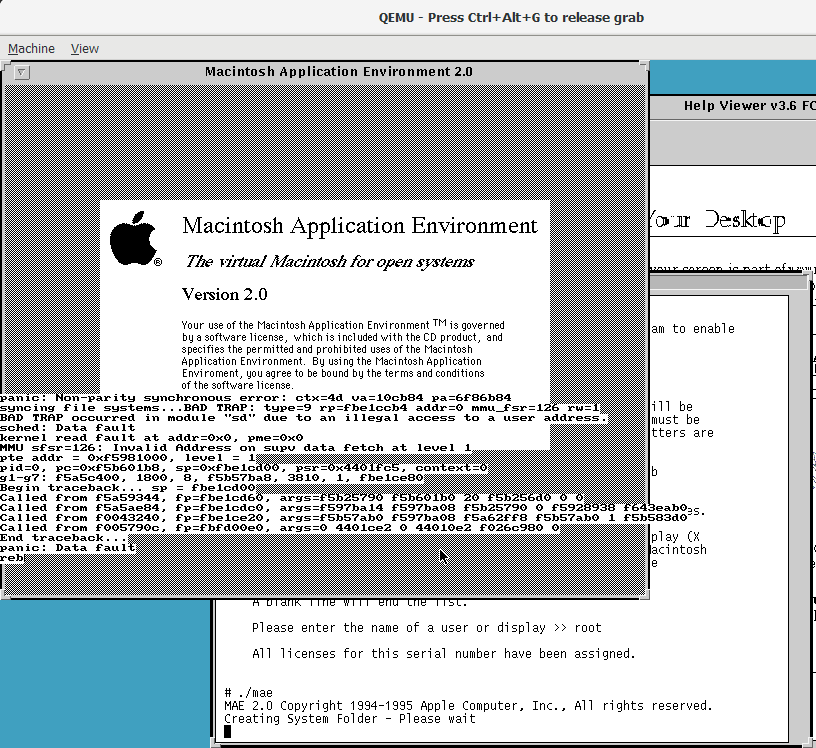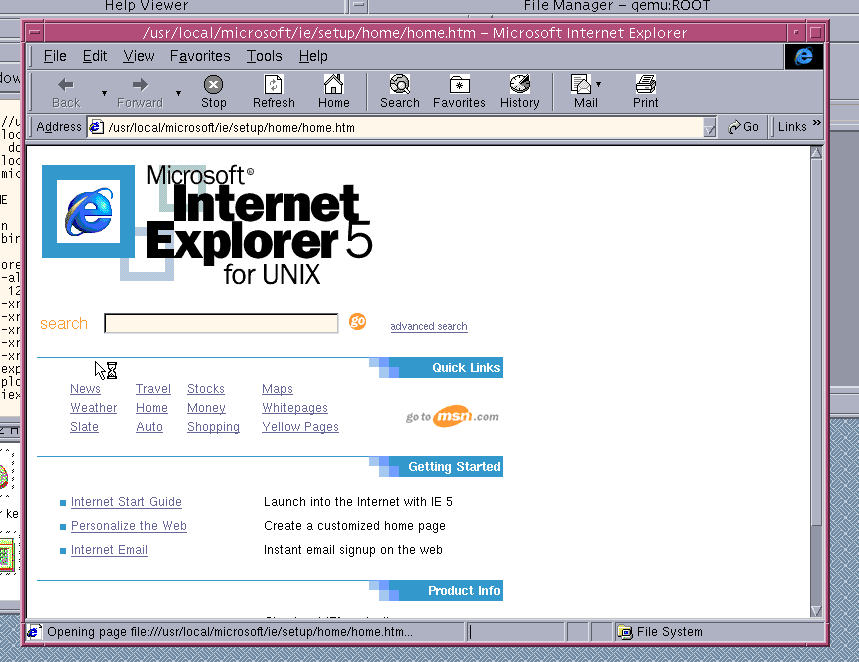It’s a rainy day, and I didn’t feel well enough to wander around outside, and check out the ‘spyware street lights’. Although that’s the latest rage at the moment along with the usual stuff.
Instead I thought it’d be fun to try some ‘undercover’ software like that time when Apple thought it would be a good idea to port the ToolBox to Unix and run it as a competitor to programs like SoftPC as people with $30,000 workstations clearly needed a virtual Macintosh.
So I spent way too much time letting my 2006 Mac Pro grind out a Solaris 2.6 install, and then using the latest Tenox dump on archive.org I installed MAE 2.0! For anyone wondering the actual serial number is: 192c4838330166201b

And after serializing the app, and running it, I get a nice kernel panic. I thought I was playing it safe by opting out of the kernel module stuff as I don’t care about reading MacOS formatted diskettes.
I guess I really need Solaris 2.4 and those weird patches.

Meanwhile you can rest assured that Internet Explorer 5.0 loads up just fine. It is painfully slow, but there it is. I was even able to download stuff with my ‘http backdoor’ thing to vpsland. So at least that works.
Hard to imagine a time that Microsoft was going cross platform under Gates, but Internet Explorer 3/4/5 were available on MacOS & OS X, with 4&5 under Solaris and HP/UX. Then of course there was that SUN Java lawsuit and they pulled the rug out from interoptability. Although I was a Linux on SPARC user in this era, having it available on Linux would have helped a LOT, but naturally Microsoft didn’t entertain that Linux market thing as it was cancer to them. Meanwhile Chromium Edge is only a Windows / OS X thing.
I was hoping to go further, but it appears not today.

Wasn’t the MacOS IE a browser that had a very different rendering engine from the Windows version, while the HP UX and Solaris were pretty much direct ports (of the Windows one)?
I believe so. I remember something about WASTE engine or something on MACOS.
IE on Solaris does have a lot of Windows sounding DLL names, so I’m sure it’s one of those commercial winelib like things.
WASTE was a text engine used by various developers, including Microsoft for Internet Explorer and Netscape. https://en.wikipedia.org/wiki/WASTE_text_engine
Britol Technology did IE port to Unix – https://web.archive.org/web/20071012220327/http://www.bristol.com/windu/
The IE4 for Windows rendering engine was Trident, the Mac one was Tasman. Personally I always liked the Mac version for its network stack; at the time I was working on SOCKS, and the Mac version could do SOCKS4 or SOCKS5 with server side name resolution, whereas the Windows version was SOCKS4 only.
I doubt things would be much different if IE had existed on Linux. The nature of the Linux community at the time meant it would have had very little use. Seriously, I used Solaris a lot back in the day, but I never saw anybody use IE on Solaris. As far as I can tell, the need for a Linux web browser is really what drove Gecko/Firefox.
Along the same lines, if you haven’t seen it, I thought Kyle Rankin’s reflections on changes in the Linux community was pretty insightful (see https://www.linuxjournal.com/content/what-linux-journals-resurrection-taught-me-about-foss-community .) The basic point is that the community changed from a group of idealists who wanted control over their desktop platform to a group of corporate interests who wanted low cost server instances. Today the idea of running Microsoft software on Linux doesn’t seem all that crazy, but in 1999 it would have been heresy.
Typo in at least one of your urls:
s(/install/)(/old/install/)
Fun fact, the company who did the IE unix port was the one who accidentally leaked the NT4 source code
I wonder if any of the MAE code ended up in the Classic environment, it would make sense to take the emulation and the scaffolding for Cut + Paste support.
MAE were supposed to run on SparcStation SS-5, SS-10 and SS-20 just fine. I can confirm running them on real hardware. Whatever kernel panic you’re seeing is a result of QEMU. I would bet on some unsupported instruction. If my memory serves me correctly Mathematica also triggered some kernel panics in QEMU emulated Sparcstations which I suspect were due to a combination of aggressive compilation optimization on the part of Wolfram, and unsupported or incorrect instructions on the emulated QEMU guests.